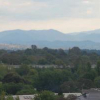Free Online Productivity Tools
i2Speak
i2Symbol
i2OCR
iTex2Img
iWeb2Print
iWeb2Shot
i2Type
iPdf2Split
iPdf2Merge
i2Bopomofo
i2Arabic
i2Style
i2Image
i2PDF
iLatex2Rtf
Sci2ools
CVPR
2008
IEEE
2008
IEEE
Visibility in bad weather from a single image
Bad weather, such as fog and haze, can significantly degrade the visibility of a scene. Optically, this is due to the substantial presence of particles in the atmosphere that absorb and scatter light. In computer vision, the absorption and scattering processes are commonly modeled by a linear combination of the direct attenuation and the airlight. Based on this model, a few methods have been proposed, and most of them require multiple input images of a scene, which have either different degrees of polarization or different atmospheric conditions. This requirement is the main drawback of these methods, since in many situations, it is difficult to be fulfilled. To resolve the problem, we introduce an automated method that only requires a single input image. This method is based on two basic observations: first, images with enhanced visibility (or clear-day images) have more contrast than images plagued by bad weather; second, airlight whose variation mainly depends on the distance of ob...
Computer Vision | CVPR 2008 | Enhanced Visibility | Gray Images | Markov Random Fields | Multiple Input Images | Single Input Image |
Related Content
| Added | 12 Oct 2009 |
| Updated | 28 Oct 2009 |
| Type | Conference |
| Year | 2008 |
| Where | CVPR |
| Authors | Robby T. Tan |
Comments (0)

